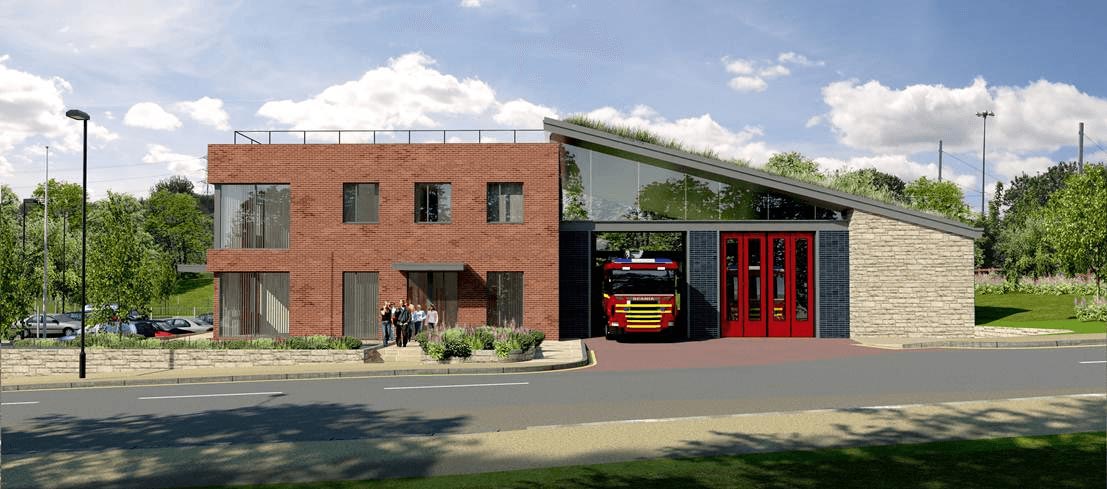From 2016, companies wanting to work on government building contracts must be able to reach BIM Level 2.
We started gearing up to use the technology in 2011 and are now using BIM on two fire stations in Sheffield with BAM Construction.
Below is our BIM diary showing our journey so far which was featured in this month’s edition of the CIBSE Journal.
NOVEMBER 2011
We are invited to attend BAM Construction’s Regional Supply Chain Partners’ Annual Review and during this meeting we are introduced to BIM, which is something that BAM are using on the new Leeds Arena project. A demonstration is given of the benefits of BIM and a short video of the virtual lifting of the main steel beams is shown which looks impressive but we wonder if this would go as smoothly on site.
NOVEMBER 2011
Driving through Leeds later that month we notice that the main steelwork truss on the Leeds Arena is being lifted into position. We pull up at the roadside and watch this for a while and are impressed that it is in fact very similar to the video seen months previously. We decide to look into BIM in more depth.
MAY 2013
The latest BIM-related story is in the news today requiring companies bidding for local authority construction contracts to use Level 2 BIM from 2016.
This is significant and makes our initial investigation work into adopting BIM a really valuable exercise going forward.
Clearly the M&E sector has to embrace this technology as soon as possible and as a forward thinking company we want to be leaders in this.
As such, we decide to press ahead and seek more information with a view to seeing how we can introduce it to the company.
AUGUST 2013
After months of monitoring the way BIM is progressing, we arrange to visit one of our largest contracting clients, BAM Construction, who is holding another event on the use of BIM.
The advantages for M&E specialists like us are plentiful and we need to take advantage of this.
From BAM Construction’s demonstration it is immediately obvious how we could benefit.
For example, we could identify in detail the locations of HVAC systems and avoid nasty surprises arising on site due to changes in any other specialist fields such as structural steelwork.
The early involvement of BIM will save time and money while ensuring any conflicting approaches by different parties can be ironed out during the pre-construction period.
Everyone’s understanding of the scope of works is increasing and BIM will allow different disciplines to focus on shared targets and add more certainty to the procurement process.
NOVEMBER 2013
The G&H Group Board has given the go-ahead to invest in BIM technology and take the necessary steps to become BIM ready.
One of the key points of BIM is that this is a collaboration process which opens up the available software to user preference. However, as long-term Autodesk customers, we decided to invest in their Revit 3D modelling software and use that as a basis for upgrading our hardware to suit. Two full BIM stations are set up in our design department.
FEBRUARY 2014
We have appointed a BIM Manager, Daniel Brook, who is experienced in AutoCAD design and is also a qualified HVAC engineer, which is a valuable and unusual combination but necessary in our opinion to bridge the possible gap between design and CAD.
Daniel has completed a Revit training course in MEP services as well as basic architecture to become proficient in its use and build a foundation for development in 3D modelling.
APRIL 2014
Following the training Daniel received, we are now testing and testing and testing again the software to maximise its use in the M&E work we carry out.
Its real capacity and scope is only now truly clear to see.
We have discovered we are not only able to model the M&E designs but also able to use the software for designing purposes such as pipe sizing, cable calculations and basic energy modelling. This has the potential to speed up design production and alternating various design software.
We have also begun to put together our own company BIM protocol based on the British Standards surrounding BIM.
MAY 2014
A major milestone. We are appointed to provide the M&E for BAM Construction’s £5 million scheme to build two fire stations at Parkway and Birley Moor in Sheffield which will be our first BIM projects.
BAM Construction provides us with additional support developing our BIM strategy, which is a great boost.
JULY 2014
As the project began, we were invited by BAM to attend the first BIM meeting to address and complete the BIM Execution Plan alongside the structural contractor.
The meeting explained how BIM would be managed, the way in which we would collaborate and who is responsible for each element.
Immediate benefits could be seen from having a full understanding of the building’s features and realising how we can co-ordinate effectively.
BIM design meetings were used to run through the co-ordinated models to understand where clashes are occurring or highlight design changes that need implementing.
We soon realise that the design process on these project will be longer than anticipated but hopefully the site installation will go smoothly with less conflicts with other trades.
SEPTEMBER 2014
Co-ordination has been found to be the key benefit to the BIM process. Throughout the project we have used the modelling aspect to co-ordinate services and highlight pinch points that we may have missed with a conventional 2D design. These are the issues that can crop up during site installation and stop works while solutions are found, often resulting in wasted staff hours and extra materials.
We have used the BIM model to design and manage builders’ works holes through walls to enable BAM Construction to manufacture the walls already pre-cut with apertures.
This will save time marking up holes, more thoughtfully minimise holes required by design services and allows for a generally tidier installation.
JANUARY 2015
Site installation has begun and already services are being installed in line with BIM produced drawings and utilising holes cut and trimmed by BAM Construction.
We quickly realise that we need to ensure the site operatives understand how BIM works on site as we find that setting out dimensions on drawings are overlooked as “better routes” are found for services but these don’t take into account the model building.
Once they are advised why the dimensions must be used then the installation commences at full speed. Mechanical services can be installed knowing that allowance is made for supporting electrical services including cross over points.
This improves the speed of installations it cuts down the “mini meetings” needed on site for coordination when a clash has actually taken place.
FEBRUARY 2015
We are now seeing the best features of BIM.
Collaboration promotes increased communication between the design team.
Updates and changes to any element or trade are discussed so the team has an understanding of what is happening with a project prior to the installation commencing.
The 3D modelling allows for faster creation using intelligent software that anticipates and adds in fittings and joints that would otherwise need to be hand drawn and would not be as accurate.
MARCH 2015
As with all new technology it evolves and there are areas for improvement with BIM.
The design process is longer than the traditional methods which impacts on the building programme.
A lot of manufacturers are already getting on board with BIM, however there are still a number without 3D model information available for use in BIM projects.
This is not a showstopper but does take time to create a BIM ready ‘block’ to use to level 2 standards.
We believe that as the 2016 deadline draws closer, more and more manufacturers will need to endorse BIM allowing for easier design and modelling of their products.
APRIL 2015
The two projects are progressing well on site and it’s anticipated that they will be completed earlier than the original programme which considering the induction design period, it is testament to the advantages of BIM which will only improve as we as an industry embrace BIM on future projects, refine its use and integrate it into all our schemes.











